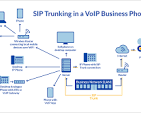The Power of VoIP Trunking: Revolutionising Communication
In the ever-evolving landscape of communication technology, Voice over Internet Protocol (VoIP) trunking has emerged as a game-changer for businesses seeking cost-effective and efficient ways to communicate. VoIP trunking allows organisations to transmit voice calls over the internet, bypassing traditional telephone lines and reducing communication costs significantly.
One of the key advantages of VoIP trunking is its scalability. Businesses can easily add or remove channels based on their communication needs, making it a flexible solution for companies of all sizes. This scalability also means that businesses only pay for the channels they use, eliminating unnecessary expenses.
VoIP trunking also offers enhanced features that are not available with traditional phone systems. These features include call forwarding, voicemail-to-email transcription, auto-attendant services, and more. Such functionalities streamline communication processes and improve overall efficiency.
Moreover, VoIP trunking enables businesses to integrate their voice communications with other digital tools and applications seamlessly. This integration enhances collaboration among team members, boosts productivity, and provides a unified communication experience across various devices.
Security is another area where VoIP trunking shines. With robust encryption protocols and advanced security measures in place, businesses can rest assured that their voice data is protected from potential threats and breaches.
As the demand for remote work continues to rise, VoIP trunking becomes even more essential. It allows employees to make and receive calls from anywhere with an internet connection, enabling seamless communication regardless of physical location.
In conclusion, VoIP trunking is revolutionising the way businesses communicate by offering cost-effective solutions, advanced features, scalability, integration capabilities, enhanced security measures, and flexibility for remote work environments. Embracing VoIP trunking can propel businesses towards greater efficiency and success in today’s digital age.
Understanding VoIP and SIP Trunking: Key Differences and Common Questions
- What is the difference between VoIP and SIP trunk?
- What is SIP trunk did?
- What is a trunk line in a phone?
- What is the difference between VoIP and SIP trunking?
- What is a SIP trunk?
What is the difference between VoIP and SIP trunk?
When exploring the realm of communication technology, a common query that arises is the distinction between Voice over Internet Protocol (VoIP) and Session Initiation Protocol (SIP) trunking. While VoIP refers to the method of transmitting voice calls over the internet, SIP trunking specifically focuses on establishing and managing these calls using the SIP protocol. In essence, VoIP is the broader concept encompassing various technologies for voice transmission, while SIP trunking is a specific application within the VoIP framework that handles call setup and signalling. Understanding this difference is crucial for businesses seeking to optimise their communication infrastructure and select the most suitable solution for their needs.
What is SIP trunk did?
A SIP trunk, or Session Initiation Protocol trunk, serves as a virtual link that connects a business’s Private Branch Exchange (PBX) system to the Public Switched Telephone Network (PSTN) via the internet. Essentially, a SIP trunk facilitates the transmission of voice calls over an IP network, allowing businesses to make and receive calls using VoIP technology instead of traditional phone lines. This modern communication solution offers cost savings, scalability, flexibility, and advanced features that enhance overall communication efficiency for organisations of all sizes.
What is a trunk line in a phone?
A trunk line in a phone system, specifically in the context of Voice over Internet Protocol (VoIP), refers to a communication channel that carries multiple voice or data signals simultaneously. It serves as a pathway for connecting different endpoints within a network, enabling the exchange of information between them. In essence, a trunk line acts as a high-capacity link that facilitates efficient and reliable communication between various devices, such as phones, computers, and servers. By utilising trunk lines in VoIP systems, businesses can streamline their communication processes, handle multiple calls concurrently, and enhance overall connectivity within their organisation.
What is the difference between VoIP and SIP trunking?
A common question that arises in the realm of communication technology is the distinction between Voice over Internet Protocol (VoIP) and Session Initiation Protocol (SIP) trunking. While VoIP refers to the general method of transmitting voice calls over the internet, SIP trunking specifically pertains to the protocol used to establish and manage these calls. In simpler terms, VoIP is the overarching technology that enables voice communication over the internet, whereas SIP trunking is a specific application within VoIP that facilitates the connection between a business’s private branch exchange (PBX) system and the internet. Understanding this difference is crucial for businesses looking to optimise their communication systems and choose the most suitable solution for their needs.
What is a SIP trunk?
A SIP trunk, short for Session Initiation Protocol trunk, is a virtual communication channel that allows businesses to make and receive voice calls over the internet using VoIP technology. Essentially, a SIP trunk serves as the bridge between a company’s phone system and the public switched telephone network (PSTN), enabling seamless voice communication without the need for traditional telephone lines. By leveraging SIP trunks, businesses can enjoy cost savings, scalability, flexibility, and advanced features that enhance their overall communication capabilities.
Tags: auto-attendant services, call forwarding, communication technology, encryption protocols, enhanced features, integration capabilities, remote work environments, scalability, security measures, session initiation protocol, sip trunking, traditional phone systems, voice over internet protocol, voicemail-to-email transcription, voip, voip trunk, voip trunking
